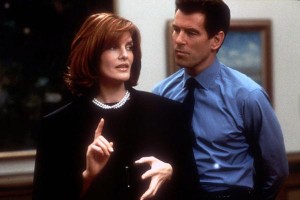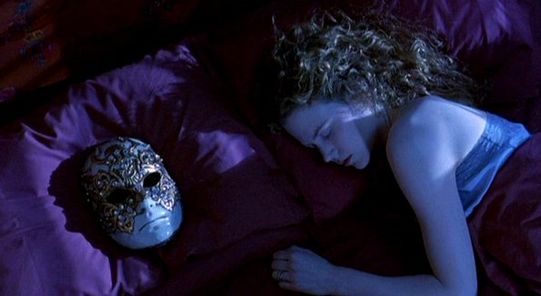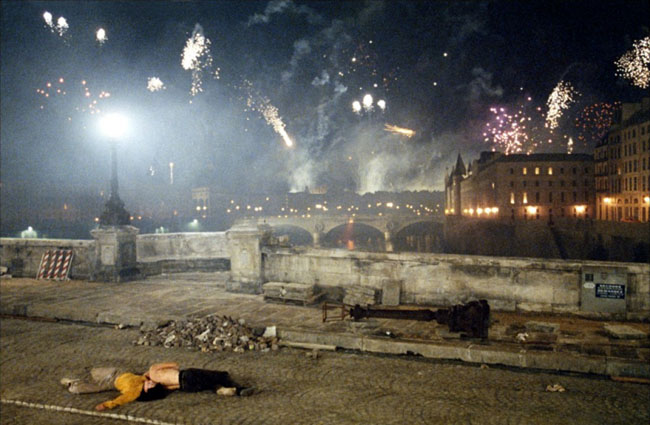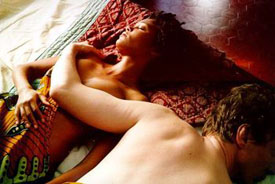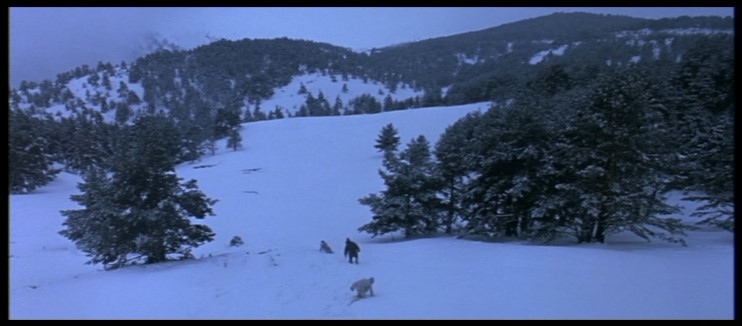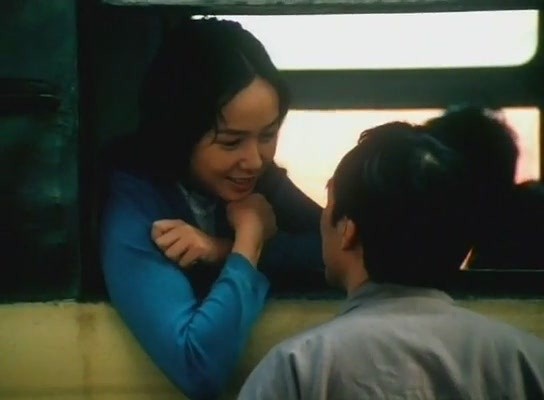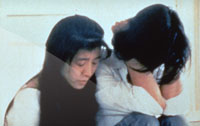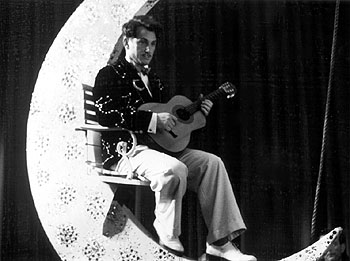From the Chicago Reader (January 7, 2000). — J.R.
I find critics’ near unanimity about hits and favorites a bit of a bore, even when I agree with some of their choices. Disputes are far more interesting, because they make artistic and political differences clearer and more meaningful. Perhaps because I’m drawn to cinema that can theoretically change the world — and me — I can’t see much purpose in commemorating movies whose prime aim seems to be to make me forget the world outside the theater. The remake of The Thomas Crown Affair and an evening of channel surfing, no matter how enjoyable either might be, are of roughly equal irrelevance.
Nineteen ninety-nine was a pivotal year in movies, clarifying where a lot of people stood and who they were. This kind of definition was encouraged by the existential stocktaking that came with the end of the millennium — the compiling of more best-film lists than usual (of the 90s, of the century) and more generalized meditating on the state of the art and the medium. (After finishing my own best-of-the-90s list for the last issue of the year, I discovered that all but one of the movies had an interesting trait in common: they hadn’t been reviewed in the New Yorker. The sole exception, Eyes Wide Shut, was treated with a dismissive contempt the reviewer would never have dreamed of heaping on a James Bond adventure.)
This happened to be the first year since 1994 that I didn’t attend the Cannes film festival. It also happened to be the first time in recent memory that a Cannes jury (headed this year by David Cronenberg) made a decisive stand against bullying Hollywood dominance and sudsy feel-good fantasies in favor of energetic and resourceful overseas art cinema — the kind of movies red-blooded Americans are presumed to hate. This welcome and unexpected move drew howls of rage from the popular press that have yet to subside, in part because the major prizewinners are still opening commercially — this country is the last place foreign pictures tend to open. (One of the heads of Miramax even threatened to boycott Cannes in the future — promises, promises — a declaration accorded more importance in the New York Times‘s festival wrap-up than any of the movies.) The top prizewinner, Rosetta — which has already inspired a new labor law in Belgium — opens at the Music Box this week, so you can judge for yourself how it stacks up against Almodovar’s All About My Mother.
The last film of Stanley Kubrick, Eyes Wide Shut, was released two months after Cannes to divided audiences everywhere. But then, ever since 2001: A Space Odyssey first appeared three decades ago, Kubrick has divided critics and audiences — at least for a while. Barry Lyndon, The Shining, and Full Metal Jacket have been increasingly revered since they first appeared, so you’d think the critics who didn’t like Eyes Wide Shut would have hesitated before popping off. Orson Welles was plagued by the same hasty judgments throughout his career: no one was ever fully ready for a new Welles movie, because everyone was still revising expectations in relation to the previous Welles movie. Confounding preconceptions is what serious artists are supposed to do, but it often irritates publicists and critics because it makes their work less cut-and-dried. Few critics learned this lesson about Welles, so why should they be any smarter about Kubrick? (Admittedly, false expectations raised by advertising played a role, and Kubrick, who helped plan the ads, was partly to blame.)
The outcry in Manhattan was particularly loud, even hysterical; one Slate writer hypothesized that Janet Maslin’s resignation as film critic for the New York Times was actually a dismissal, occasioned by her favorable review of Eyes Wide Shut, which “everyone” knew was awful. (A ponderous think piece in Brill’s Content contained tortured reasoning, in this case about why some American reviewers liked the film.) That Maslin was no less enthusiastic about Star Wars: Episode I–The Phantom Menace apparently cut no ice with this commentator. We also heard the complaint — voiced most frequently by the Village Voice‘s J. Hoberman — that the film wasn’t finished, or at best had been finished by the studio, a charge the complainers justified by noting that Kubrick hadn’t completed the sound mixing. I too wondered about this for a while, but an excellent British TV documentary featuring the Kubrick household — virtually a home movie showing family, employees, friends, pets, manor, and grounds — made it evident that Kubrick’s widow, herself an artist, considered the film finished. If she doesn’t regard the released movie as a studio pasteup, why should we?
A much more plausible rumor about the film — two well-informed studio directors insist it’s true — is that Time Warner vice chairman Ted Turner’s rage about Eyes Wide Shut being released precipitated the resignation of two top Warners executives. I haven’t a clue what Turner was angry about — aesthetic, sexual, or business concerns, or some combination thereof — but it seems fitting that even after his death Kubrick caused a ruckus.
A few caveats before proceeding to my list of the best films of 1999. Like every other reviewer, I haven’t seen all the films shown in Chicago last year. And when, where, and how I saw movies usually played some role in what I thought of them, though I’ve done my best to minimize that role. Still, when I finally caught up with The Sixth Sense it was in a movie theater in downtown Kyoto, where the house lights were left on and the Japanese subtitles appeared alternately on the right and left sides of the frame, which enhanced my sense of the framing. And I saw Eyes Wide Shut for the third time in Vienna, where it was running without subtitles and without the digitally added figures in the orgy sequence (I couldn’t tell whether the chanting of the Bhagavad Gita during the same sequence had been replaced by other chanting, as I’m told it was, at great expense, in England, because of Hindu protests). Yet it was at this screening that I first noticed a telling detail in the sequence with Marie Richardson — a figurine on a table whose face is identical to one of the masks at the orgy — that enhances the dreamlike continuity of the film as a whole.
Finally, my sense of which films are the best is defined largely by which ones continue to teach me things after I leave the theater. And there were many more of those films in 1999 — a very good sign.
1. Eyes Wide Shut. Part of what irked some reviewers about Kubrick’s eccentric masterpiece is one of the things I treasure about it–its distance from its own period. This quality is shared by at least two sublime testament films released in the 60s to similar amounts of scorn, Carl Dreyer’s Gertrud (1964) and John Ford’s 7 Women (1966). Both of them are clearly set in earlier periods; Kubrick’s is purportedly set in present-day New York but was adapted from “Traumnovelle,” a 1926 novella by Arthur Schnitzler set in prewar Vienna. All three depend on highly stylized and subjective renderings of time and place that become an essential part of their memory-laden textures. (To correct two factual errors in my original review: the prewar setting of Schnitzler’s novella can be gleaned from a reference to Bohemia, not Czechoslovakia, and Schnitzler wasn’t a friend of Freud’s but an ambivalent contemporary reader of his work, though Freud did once refer to Schnitzler as his “doppelganger,” apparently because they held some similar notions about psychology.)
Like many an artist before him, Kubrick went from being part of his own time — for better and for worse, Dr. Strangelove (1964), 2001 (1968), and A Clockwork Orange (1971) are uncannily in tune with the preoccupations of their periods — to being in a time frame of his own, which is apparent in Barry Lyndon (1975), Full Metal Jacket (1987), and Eyes Wide Shut. (His 1980 The Shining is arguably a throwback.) He gives almost no attention to the particulars of living in New York in the 90s, since his “contemporary” Manhattan is basically a throwback to the 60s, the last time he lived there — which may be one reason this movie offended a few New York egos.
Eyes Wide Shut has a lot to say about the psychological accommodations of marriage — and has a sunnier view of human possibility than any other Kubrick film, in spite of all its dark moments. It depends on a sense of the shared mental reality of a couple that almost supersedes any sense of their shared physical reality, a strange emphasis that’s probably the source of most of the confusion felt by everyone in the course of processing the story. (A similar sense of shared mental reality can be found in the title characters of Schnitzler’s startling, almost equally masterful 1913 novella “Beatrice and Her Son.”) A list of the things we never learn about the characters is at least as long as the list of things we know with any certainty. We remain in the dark about how the wife happens upon the mask worn by the husband at the orgy, about whether he tells her the entire truth about his adventures, about the accuracy of Ziegler’s account of many of those same adventures, and even about whether they happen outside the husband’s imagination. Yet there’s never any doubt about what transpires emotionally between this husband and wife (Tom Cruise and Nicole Kidman). Kidman is on-screen only a fraction as long as Cruise, but that doesn’t prevent her from being equally important and even present in the ongoing action, especially since every other woman in the movie is a doppelganger for her. Kubrick’s grace in fashioning such subtle rhymes marks this movie as a masterpiece.
2. The Thin Red Line. I still haven’t read James Jones’s 1962 novel about World War II and therefore can’t gauge the degree to which Terrence Malick’s grasp of collective consciousness, as acute and as eccentric as Kubrick’s, is the product of adaptation or of invention. But Malick’s remarkable, at times visionary evocation of a collective hero–a group of soldiers and officers ruminating in offscreen monologues with essentially the same voice — is basically a reactionary throwback to lyrical-humanist depictions of World War I from the first third of this century, novels such as Three Soldiers (1921), The Enormous Room (1922), and Company K (1933) and films such as The Big Parade (1925) and All Quiet on the Western Front (1930). Malick’s most visible influence is F.W. Murnau’s Tabu (1930), a late silent picture that deals not with war but with “natural” innocence and “civilized” corruption in the South Seas.
All this makes Malick’s beautiful and moving epic somewhat questionable as history — unless one can accept his “retreat” into a silent-movie sensibility as a step forward. This isn’t a position to be rejected out of hand: a few years ago historian Eric Hobsbawm argued in New Left Review that “after about 150 years of secular decline, barbarism has been on the increase for most of the 20th century, and there is no sign that this increase is at an end.” He wrote that “the First World War began the descent into barbarism” and that “civilization receded between the Treaty of Versailles and the fall of the bomb on Hiroshima.” With that as a given, taking a World War I-era view of World War II would be relatively civilized — a step backward into relative sanity.
Whatever one concludes about the wisdom of Malick’s philosophical or aesthetic approach, the film’s first couple of hours offer a deeply stirring experience (during the final hour its power dissipates). Many other films this year gained from having a silent-movie syntax, including The Lovers on the Bridge, Besieged, and Winstanley, and there were a few moments in Eyes Wide Shut that gained as well. But The Thin Red Line is probably the one that buys into the ideological content of silent movies the most, for good and for ill.
3. Rushmore. I’m at a loss to explain why this lovable comedy, directed by Wes Anderson from a script he wrote with Owen Wilson, flopped commercially when it opened here in February. I refuse to believe that its treatment of youth was too poetic or subtle for audiences — if so, why did they respond so well to the poetry and subtlety of The Sixth Sense? Maybe it was too strange, too self-consciously involved with its own style. I felt while watching it that it was about as close to 90s Lubitsch as we deserve to get — with a romantic wistfulness about adolescent loneliness, class differences, and age differences that managed to be highly fanciful, even utopian, without ever glossing over the pain inherent in all three. Maybe the pain cut too deep, despite the happy ending and the presence of Bill Murray, in what has to be his loveliest performance. Or maybe the movie would have found its audience if Disney had figured out the right way to publicize it and keep it in theaters — no easy matter when the Schwarzeneggers of this world command all the ad budgets and column inches. Rushmore cries out for the court of second appeal offered by video and certainly deserves a full-blown cult, though if its wide-screen dimensions are trimmed, its special qualities may not survive.
4. A tie between two documentaries that surfaced here last January, Divorce Iranian Style and Narita: Heta Village. The first, which played at the Film Center, was directed by English documentarian Kim Longinotto and London-based Iranian anthropologist Ziba Mir-Hosseini, and its content is what makes it exciting: it’s a compilation of Iranian court battles, sometimes funny and always fascinating, in which unhappily married women facing the most restrictive laws imaginable employ all their resources — intelligence, anger, aggression — to overcome their husbands’ resistance to getting divorced.
The style of the second is what makes it exciting, though its content — including the interactions between the filmmakers and their subjects — is also intriguing. Made in 1973, Narita: Heta Village, which was screened by the University of Chicago’s Doc Films, is the only segment I’ve seen of Shinsuke Ogawa’s five-part, 15-hour documentation of the protests by farmers against the demolition of their village to make room for Tokyo’s Narita airport. Wholly absorbing and varied, this 146-minute feature is closer to conversation than to statement: Ogawa lived for seven years with the farmers he filmed, and Masaki Tamura’s camera movements are every bit as subjective as Ogawa’s style of interviewing and narration, continually redefining the space of social events in highly original and sensitive ways.
5. I Stand Alone. On all counts the most upsetting film I saw all year turned up at the Music Box: Gaspar Noe’s unblinking 1998 look into the mind of a fascist, sexist, and racist out-of-work butcher (Philippe Nahon), which is upsetting largely because it requires the viewer’s uneasy complicity. This much-delayed sequel to Noe’s 40-minute Carne — a less successful and memorable work, though it contains many of the same elements — is shocking because of the violence in scenes near the beginning and end of the film and because of the undercurrent of violence throughout, created through formal means and through the butcher’s stream-of-consciousness narration. Set in France in 1980, when Le Pen was still emerging as a political force, I Stand Alone does more with ‘Scope framing and sound editing, with offscreen sound and jagged jump cuts, with ratty wallpaper and dirty mirrors, than one might have thought possible given the unrelenting bleakness of the subject. Maybe because every formal move coincides with a moral challenge, it calls to mind a Taxi Driver stripped of the cushy attributes — glamorous star, romantic music, adolescent sentimentality, noir stylishness — that made it palatable.
6. The Lovers on the Bridge. Seven years passed between the French release of Leos Carax’s Les amants du Pont-Neuf (“The Lovers of Pont-Neuf”) and its opening last month at the Music Box under a less specific title. Reportedly, part of the reason for the delay was the asking price of the producer, who was angry that the film was one of the most expensive in the history of French cinema. Yet the film was released in England ages ago. (This week the same English distributor released Time Regained, Raul Ruiz’s impressive, star-filled adaptation of the last volume of Proust’s Remembrance of Things Past, but I’ve heard that a U.S. release is unthinkable because Janet Maslin gave the film an unfavorable notice when it showed at the New York film festival last fall. Is the American movie audience really so plugged into her nervous system, or are distributors afraid to let us think for ourselves, independent of New York philistines?)
As an apotheosis of a certain kind of expressionist studio filmmaking positing a luminous city as a lovers’ plaything — a tradition that can be traced back to silent pictures like Murnau’s Sunrise as well as to Robert Bresson’s Four Nights of a Dreamer, which was also centered on Paris’s Pont-Neuf — Carax’s giddy frolic still carries a punch. While Americans were waiting to see it, one of its stars, Juliette Binoche, received an Oscar (the other, Denis Lavant, a star in Carax’ two previous features, is also in Claire Denis’ magical Beau travail, which will be released in the U.S. sometime this year).
7. A tie between Bernardo Bertolucci’s Besieged and Tsai Ming-liang’s The Hole, two films that made extensive use of music as they portrayed the mainly silent and erotic interactions between a man and a woman who live on separate floors of the same building in a city. Both films have come under attack — Besieged for racism, The Hole for sexism — but neither charge is deserved.
Despite the parallels, these movies aren’t much alike. Besieged, which opened at the Fine Arts in June, is set in a Roman villa near the Spanish Steps where a piano teacher (David Thewlis) falls in love with his African maid (Thandie Newton). The Hole is a millennial SF film set in the present — a 95-minute Taiwanese feature that played at the Chicago International Film Festival and has surfaced in a 69-minute version called Last Dance at the Film Center and on digital cable. It focuses on neighbors in a Taipei high-rise during an epidemic that has driven everyone else out of the neighborhood. Periodically the characters break into full-scale musical numbers that re-create the Hong Kong musicals of the 50s, but otherwise they scarcely communicate at all.
8. A tie between a pair of palindromic films: Julio Medem’s The Lovers of the Arctic Circle, a witty and haunting Spanish feature that opened at the Fine Arts in May, and a 35-millimeter experimental film by Caspar Stracke, Circle’s Short Circuit, that Chicago Filmmakers presented in September. I regret that I was able to see the latter only on video, though even in that format the circular structure and the continual transformations — a lecture turning into a story, a piece of performance art growing out of an essay — kept me mesmerized.
9. One more two-way tie, between films that played at Facets Multimedia Center: Shohei Imamura’s Doctor Akagi, a robust and imaginative Japanese farce about a compassionate doctor set during the final days of World War II, and Mr. Zhao, a beautifully acted, psychologically rich comedy about an adulterer in Shanghai — the directorial feature debut of Lu Yue, a highly accomplished cinematographer from mainland China who’s been visibly influenced by John Cassavetes.
10. I began this list with three American studio productions, and I’ll end it with a tie involving four more: American Beauty, Being John Malkovich, The Sixth Sense, and Three Kings. The first is corruptly if cleverly conceived — a piece of kiddie porn and middle-aged-woman bashing with lots of hokey New Age mysticism; scripted by Alan Ball and brilliantly shot by Conrad Hall and directed by Sam Mendes (his feature debut), it turned me into a guilty sucker for its diverse charms. Being John Malkovich is a brilliantly conceived lunatic farce about sexual fantasies and squeezed circumstances (though by the end it pops like an overinflated balloon), brilliantly written by Charlie Kaufman and adequately directed by Spike Jonze. The Sixth Sense is a delicate ghost story with a few jolts about the difficulty kids have being listened to, written and directed with a nice sense of atmospherics by M. Night Shyamalan; this was the big sleeper of the year I was aware of, apart from The Blair Witch Project, a horror movie with less delicacy but plenty of jolts, especially if one reads it as an unconscious allegory about American isolationism and innocence. Finally Three Kings, the first memorable David O. Russell film, did as much as The Thin Red Line to revise my notion of the possibilities of the war film. Russell demonstrated that action kicks and a relatively honest (albeit guilty-liberal) look at the gulf war aren’t necessarily incompatible–a thought that would never occur to an emotional bully like Steven Spielberg.
If 1999 hadn’t been such a good year for movies I might have found room on my list for some of these other releases: Rob Tregenza’s impossibly ambitious Inside/Out, Nobuhiro Suwa’s Rivette-like and improvised Duo (which featured more remarkable camera work by Masaki Tamura), Aktan Abdikalikov’s The Adopted Son (with its dazzling mixtures of color and black-and-white footage), Ken Loach’s My Name Is Joe (especially for Peter Mullan’s performance), Kevin Brownlow and Andrew Mollo’s 1975 Winstanley, Peter Ho-sun Chan’s scandalously underrated The Love Letter, Maggie Hadleigh-West’s edgy documentary War Zone (about harassing her own harassers on the street), Abel Ferrara’s New Rose Hotel (a fascinating piece of delirium that might have qualified as another palindrome movie if it had been slightly more coherent), Hirokazu Kore-eda’s After Life, Wim Wenders’s Buena Vista Social Club (his most selfless documentary and his best picture in years), Spike Lee’s Summer of Sam (especially for John Leguizamo), Youssef Chahine’s robust 1958 Cairo Station and his freewheeling 1997 Destiny, Andrew Fleming’s hilarious Dick (the perfect antidote to Oliver Stone’s cretinous Nixon), Eric Rohmer’s Autumn Tale (his best in years), Jeremy Thomas’s All the Little Animals (for its unabashed revival of primal melodrama), Manoel de Oliveira’s Voyage to the Beginning of the World, Olivier Assayas’s Late August, Early September (for its novelistic handling of evolving relationships), Yasuzo Masumura’s 1965 Hoodlum Soldier, Jacques Rivette’s Secret Defense, Brad Bird’s The Iron Giant and Hayao Miyazaki’s Princess Mononoke (my two favorite animated features), Emir Kusturica’s Black Cat, White Cat, Theo Angelopoulos’s Eternity and a Day (familiar art-movie stuff but executed like a gorgeous piece of music), and Woody Allen’s Sweet and Lowdown (mainly for Sean Penn and a few good guitar solos).
My annual F.W. Murnau award — for the film or films that did the most to enhance my sense of film history — goes to the Film Center for its Robert Bresson retrospective last spring, assembled through the untiring initiative of Toronto programmer James Quandt. These movies didn’t actually change my sense of film history, because I’ve been a Bresson fan for over half my life. (I even had the pleasure of appearing as an extra in one of his features, Four Nights of a Dreamer.) But I did make the happy discovery that, once packaged correctly and promoted intelligently, the films of a supposedly esoteric director could fill theaters and auditoriums. These powerful and precious works, none of which registers adequately on video, played to capacity houses in new 35-millimeter prints across the country, and the same full retrospective appeared in Tokyo a couple of months ago. When Bresson died in his late 90s last month, his global reputation was at its peak.

